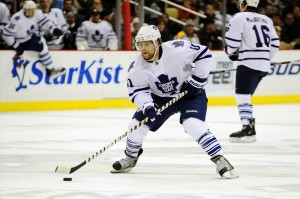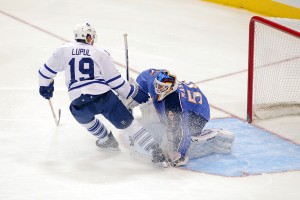There’s no doubt things change when it comes to NHL players. It can be difficult to get a handle on how a player will perform, even after you’ve picked apart every detail of his previous work. There are many variables, such as maturation and development rate, changes in coaching, linemates or conditioning. Certainly, there are trends that can be found in analysis of past seasons, and people more ‘numbers-oriented’ than I will discuss CORSI and regression and other means of measuring performance. But despite observation and all the tools available, sometimes, it’s just difficult to accurately predict the future.

Last season, there was plenty of predicting and reflecting when people talked about Phil Kessel. And plenty of the predicting and reflecting said that Phil, as nice a kid he may be, was simply one of those players with skill enough to score, but he was never going to be more than a one-dimensional player. Stories popped up that he wasn’t a team guy, he had issues with Claude Julien, he had issues with Ron Wilson. Sure, he could score when playing with Marc Savard, but with anyone else…
There were high expectations due to ‘the trade’ – the projected success of Tyler Seguin, Jared Knight and Dougie Hamilton versus what Kessel’s numbers. Mid-season saw Kessel selected last overall during the All-Star Draft. And ultimately, though Phil posted a 3rd consecutive 30 goal season, his team missed the playoffs and much of the talk concerned how Kessel was okay, he’d certainly never be a complete player, and without a top-flight centre he might not be more than an average scorer at that.
Whether he didn’t like what happened at the All Star Draft, or he didn’t care for all the talk, or he just decided he could do better, the 2011-12 edition of Phil Kessel is a different player. There were signs last season, sure. The way he and Joffrey Lupul played in the latter part of 2010-11, it looked as though they might be parts of a very good line. But, it’s not likely many predicted what has occurred as the Leafs hit the midway mark of the season.
Together, Kessel and Lupul have been a force for Toronto, and have both been at or near the top in terms of league scoring. After 42 games, Phil has scored 24 goals and has 48 points, Joffrey close behind with 47. Those numbers put them both on a 90+ point pace, levels neither has previously achieved.
It’s not really just numbers. There’s consistency there, as Kessel has been pointless in only 9 games this year (and never more than 1 game at a time). Compare that to previous years where he’d disappearing for 5, 10 games. Further, Kessel and Lupul have worked with a number of centres; primarily Tyler Bozak, but also Tim Connolly, Matthew Lombardi and David Steckel have played between the wingers. It’s difficult to predict success will necessarily continue, but, among the main criticisms of Kessel were that he needed to have a skilled centre he had chemistry with, that he could not be counted on for clutch scoring, and that he disappeared for long stretches too often. Those situations seem to have changed, at least in the first half this year.
Kessel has always had the ability to get himself open. and to create in offensive situations. It was his apparent lack of desire to play the defensive game that got him a reputation as a cherry-picker, too eager to blow the zone looking for the stretch pass, making high-risk decisions that seemed to cost the team. This is another facet of Phil’s game that has changed. He still creates offense, he still looks for the stretch pass, and the results can be spectacular. He has been a more responsible player defensively though, more involved inside his own blueline. This has helped the Leafs to breakout more effectively. Jason Siegel pointed out that the top line as a whole were getting burned for defensive breakdowns, though in recent games, the overall team defense has been better. A stats analysis of the team from mid-December showed the Kessel line is not the best defensive group on the team. But anecdotal evidence since the season began says it’s been noticeable how Kessel has been more willing to battle on the boards, chip pucks out, and put himself in positions to help defensively, which in turn seems to have resulted in better offensive chances developing out of transition.

It should be noted that Lupul is on pace to outdo his career goals high of 28 by 9, and is currently only 6 points off his career high 53 (2005-06, ANA). He is also a +8, and it’s apparent that he and Kessel are playing well together. It may be fair to say the wingers compliment each other such that they’ve elevated each other’s games.
Last season Kessel went to the NHL All-Star Game as arguably the Leafs’ most talented player, though not necessarily their best player. This season it’s a different story. Yes, overall the team is better than last season, and Kessel is joined by Lupul and Dion Phaneuf. It is fair to say that Phil has benefit from the overall team improvement. But to chalk it all up to that would be to deny that Kessel has taken it upon himself to improve also. He is going to the All-Star Game this time because he is a bonafide all-star. He has arguably been Toronto’s best player. The final analysis may show that Boston got the better of the trade that sent Phil to the Leafs, but it appears Kessel is determined to equal things out.